Review: Impact of Leadership Style on Employee Performance - Cote
VerifiedAdded on 2023/06/18
|12
|3335
|259
Literature Review
AI Summary
This literature review examines the impact of leadership styles on employee performance and productivity at Cote Restaurant, a modern French brasserie chain in the UK. It presents data and explores leadership models and theories, including situational, participative, and transformational leadership. The review discusses how different leadership styles can motivate employees, improve performance, and contribute to organizational success. It also considers the potential drawbacks of each style and emphasizes the importance of adapting leadership approaches to specific situations. The analysis draws upon various academic sources to provide a comprehensive overview of leadership theories and their practical application within the context of Cote Restaurant. Desklib offers solved assignments and past papers for students.

COTE RESTAURANT
Paraphrase This Document
Need a fresh take? Get an instant paraphrase of this document with our AI Paraphraser
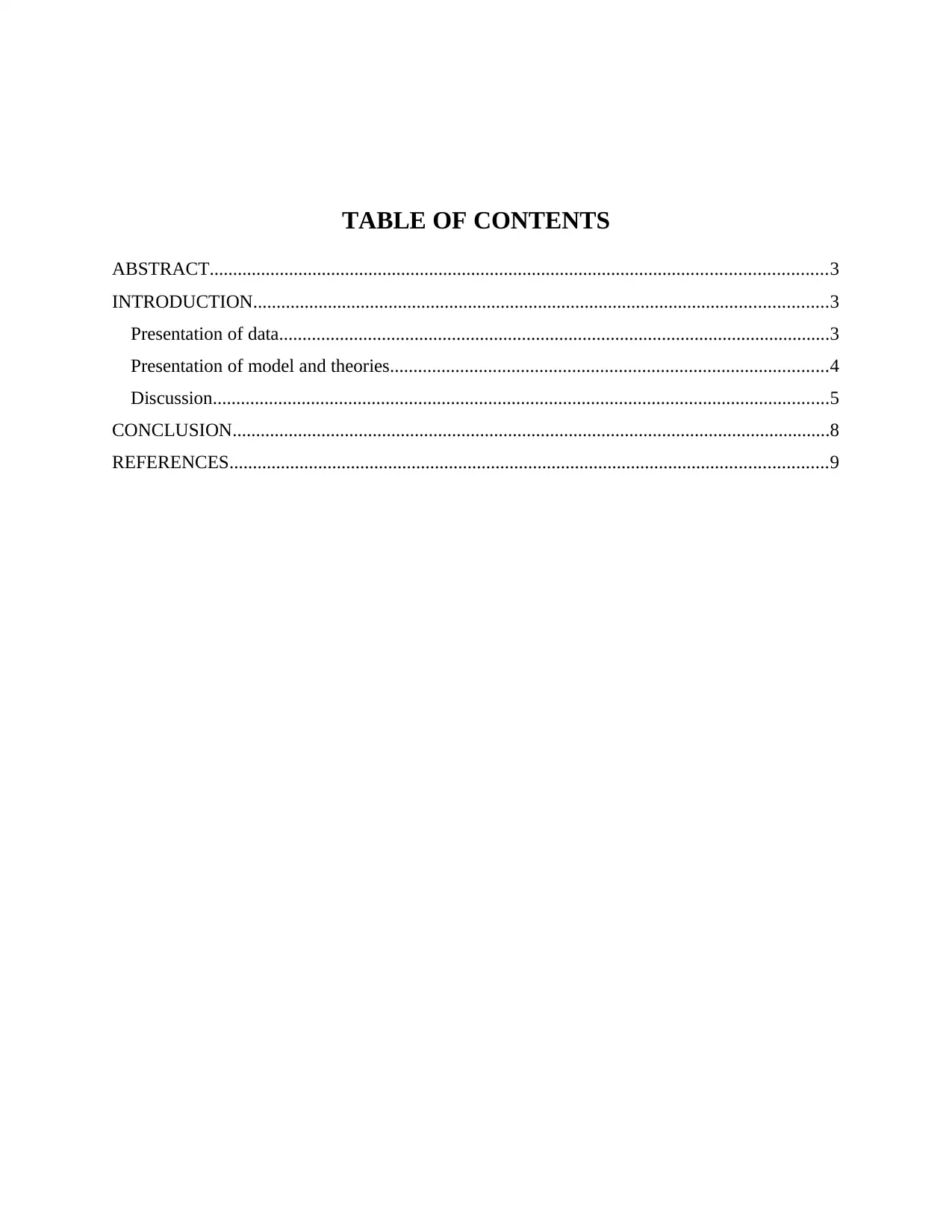
TABLE OF CONTENTS
ABSTRACT....................................................................................................................................3
INTRODUCTION...........................................................................................................................3
Presentation of data......................................................................................................................3
Presentation of model and theories..............................................................................................4
Discussion....................................................................................................................................5
CONCLUSION................................................................................................................................8
REFERENCES................................................................................................................................9
ABSTRACT....................................................................................................................................3
INTRODUCTION...........................................................................................................................3
Presentation of data......................................................................................................................3
Presentation of model and theories..............................................................................................4
Discussion....................................................................................................................................5
CONCLUSION................................................................................................................................8
REFERENCES................................................................................................................................9
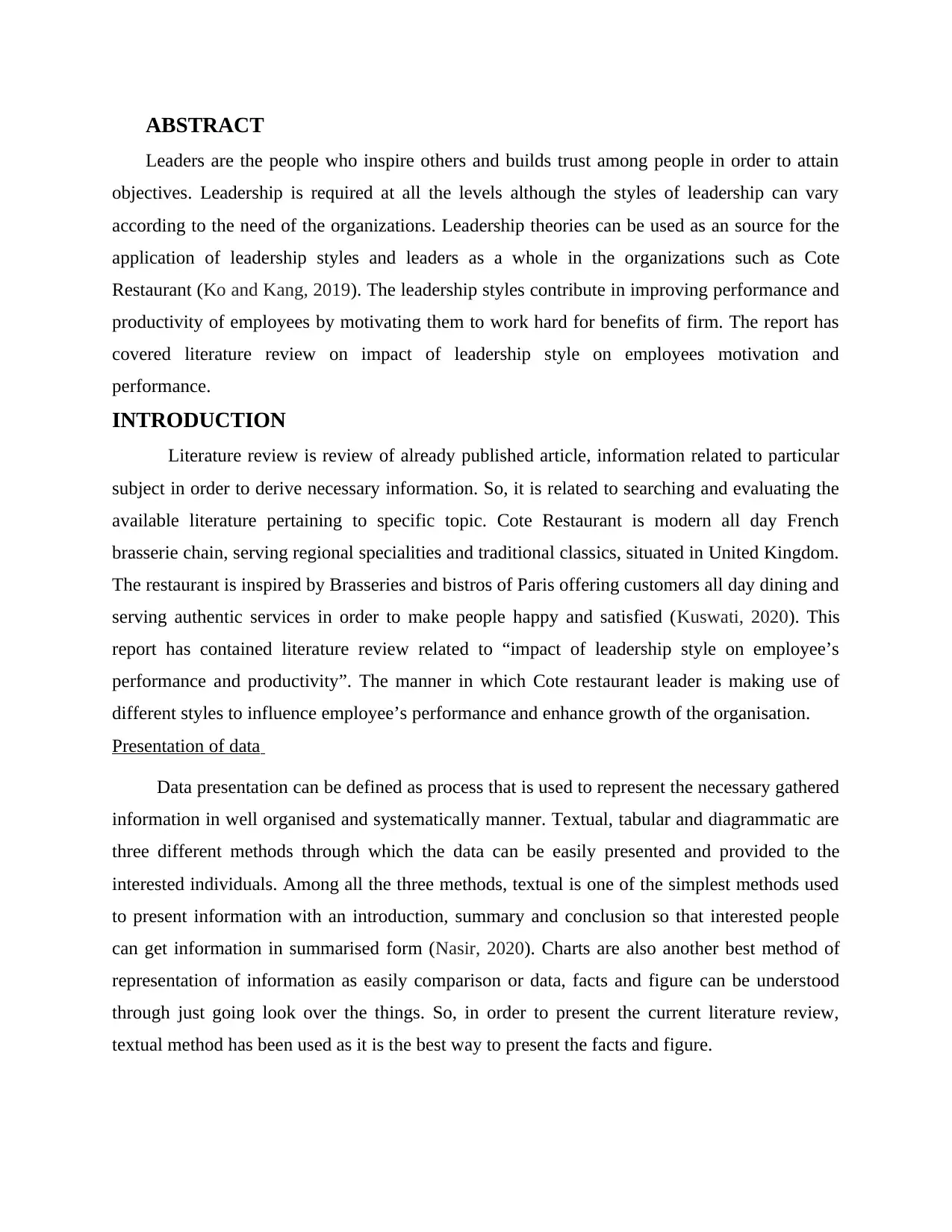
ABSTRACT
Leaders are the people who inspire others and builds trust among people in order to attain
objectives. Leadership is required at all the levels although the styles of leadership can vary
according to the need of the organizations. Leadership theories can be used as an source for the
application of leadership styles and leaders as a whole in the organizations such as Cote
Restaurant (Ko and Kang, 2019). The leadership styles contribute in improving performance and
productivity of employees by motivating them to work hard for benefits of firm. The report has
covered literature review on impact of leadership style on employees motivation and
performance.
INTRODUCTION
Literature review is review of already published article, information related to particular
subject in order to derive necessary information. So, it is related to searching and evaluating the
available literature pertaining to specific topic. Cote Restaurant is modern all day French
brasserie chain, serving regional specialities and traditional classics, situated in United Kingdom.
The restaurant is inspired by Brasseries and bistros of Paris offering customers all day dining and
serving authentic services in order to make people happy and satisfied (Kuswati, 2020). This
report has contained literature review related to “impact of leadership style on employee’s
performance and productivity”. The manner in which Cote restaurant leader is making use of
different styles to influence employee’s performance and enhance growth of the organisation.
Presentation of data
Data presentation can be defined as process that is used to represent the necessary gathered
information in well organised and systematically manner. Textual, tabular and diagrammatic are
three different methods through which the data can be easily presented and provided to the
interested individuals. Among all the three methods, textual is one of the simplest methods used
to present information with an introduction, summary and conclusion so that interested people
can get information in summarised form (Nasir, 2020). Charts are also another best method of
representation of information as easily comparison or data, facts and figure can be understood
through just going look over the things. So, in order to present the current literature review,
textual method has been used as it is the best way to present the facts and figure.
Leaders are the people who inspire others and builds trust among people in order to attain
objectives. Leadership is required at all the levels although the styles of leadership can vary
according to the need of the organizations. Leadership theories can be used as an source for the
application of leadership styles and leaders as a whole in the organizations such as Cote
Restaurant (Ko and Kang, 2019). The leadership styles contribute in improving performance and
productivity of employees by motivating them to work hard for benefits of firm. The report has
covered literature review on impact of leadership style on employees motivation and
performance.
INTRODUCTION
Literature review is review of already published article, information related to particular
subject in order to derive necessary information. So, it is related to searching and evaluating the
available literature pertaining to specific topic. Cote Restaurant is modern all day French
brasserie chain, serving regional specialities and traditional classics, situated in United Kingdom.
The restaurant is inspired by Brasseries and bistros of Paris offering customers all day dining and
serving authentic services in order to make people happy and satisfied (Kuswati, 2020). This
report has contained literature review related to “impact of leadership style on employee’s
performance and productivity”. The manner in which Cote restaurant leader is making use of
different styles to influence employee’s performance and enhance growth of the organisation.
Presentation of data
Data presentation can be defined as process that is used to represent the necessary gathered
information in well organised and systematically manner. Textual, tabular and diagrammatic are
three different methods through which the data can be easily presented and provided to the
interested individuals. Among all the three methods, textual is one of the simplest methods used
to present information with an introduction, summary and conclusion so that interested people
can get information in summarised form (Nasir, 2020). Charts are also another best method of
representation of information as easily comparison or data, facts and figure can be understood
through just going look over the things. So, in order to present the current literature review,
textual method has been used as it is the best way to present the facts and figure.
⊘ This is a preview!⊘
Do you want full access?
Subscribe today to unlock all pages.

Trusted by 1+ million students worldwide
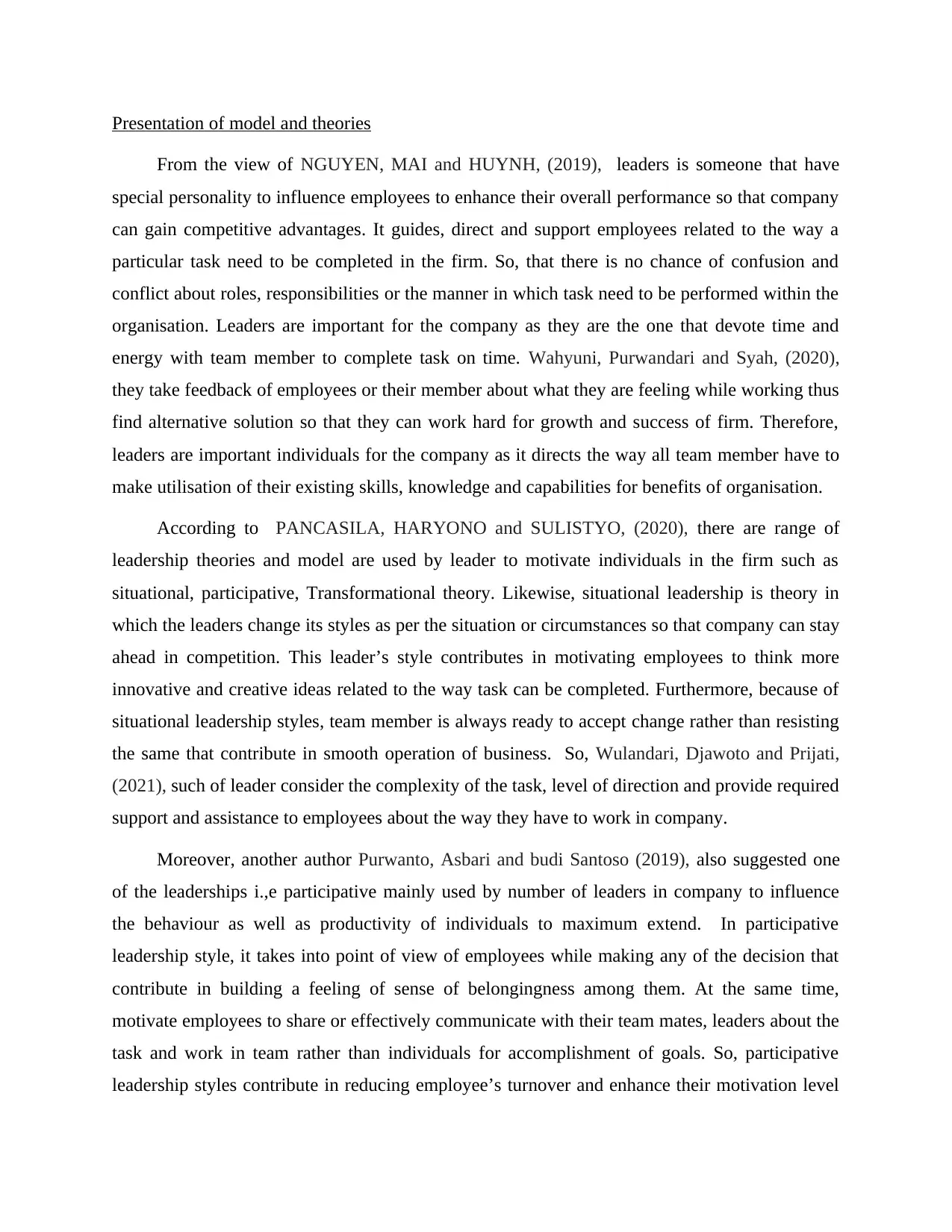
Presentation of model and theories
From the view of NGUYEN, MAI and HUYNH, (2019), leaders is someone that have
special personality to influence employees to enhance their overall performance so that company
can gain competitive advantages. It guides, direct and support employees related to the way a
particular task need to be completed in the firm. So, that there is no chance of confusion and
conflict about roles, responsibilities or the manner in which task need to be performed within the
organisation. Leaders are important for the company as they are the one that devote time and
energy with team member to complete task on time. Wahyuni, Purwandari and Syah, (2020),
they take feedback of employees or their member about what they are feeling while working thus
find alternative solution so that they can work hard for growth and success of firm. Therefore,
leaders are important individuals for the company as it directs the way all team member have to
make utilisation of their existing skills, knowledge and capabilities for benefits of organisation.
According to PANCASILA, HARYONO and SULISTYO, (2020), there are range of
leadership theories and model are used by leader to motivate individuals in the firm such as
situational, participative, Transformational theory. Likewise, situational leadership is theory in
which the leaders change its styles as per the situation or circumstances so that company can stay
ahead in competition. This leader’s style contributes in motivating employees to think more
innovative and creative ideas related to the way task can be completed. Furthermore, because of
situational leadership styles, team member is always ready to accept change rather than resisting
the same that contribute in smooth operation of business. So, Wulandari, Djawoto and Prijati,
(2021), such of leader consider the complexity of the task, level of direction and provide required
support and assistance to employees about the way they have to work in company.
Moreover, another author Purwanto, Asbari and budi Santoso (2019), also suggested one
of the leaderships i.,e participative mainly used by number of leaders in company to influence
the behaviour as well as productivity of individuals to maximum extend. In participative
leadership style, it takes into point of view of employees while making any of the decision that
contribute in building a feeling of sense of belongingness among them. At the same time,
motivate employees to share or effectively communicate with their team mates, leaders about the
task and work in team rather than individuals for accomplishment of goals. So, participative
leadership styles contribute in reducing employee’s turnover and enhance their motivation level
From the view of NGUYEN, MAI and HUYNH, (2019), leaders is someone that have
special personality to influence employees to enhance their overall performance so that company
can gain competitive advantages. It guides, direct and support employees related to the way a
particular task need to be completed in the firm. So, that there is no chance of confusion and
conflict about roles, responsibilities or the manner in which task need to be performed within the
organisation. Leaders are important for the company as they are the one that devote time and
energy with team member to complete task on time. Wahyuni, Purwandari and Syah, (2020),
they take feedback of employees or their member about what they are feeling while working thus
find alternative solution so that they can work hard for growth and success of firm. Therefore,
leaders are important individuals for the company as it directs the way all team member have to
make utilisation of their existing skills, knowledge and capabilities for benefits of organisation.
According to PANCASILA, HARYONO and SULISTYO, (2020), there are range of
leadership theories and model are used by leader to motivate individuals in the firm such as
situational, participative, Transformational theory. Likewise, situational leadership is theory in
which the leaders change its styles as per the situation or circumstances so that company can stay
ahead in competition. This leader’s style contributes in motivating employees to think more
innovative and creative ideas related to the way task can be completed. Furthermore, because of
situational leadership styles, team member is always ready to accept change rather than resisting
the same that contribute in smooth operation of business. So, Wulandari, Djawoto and Prijati,
(2021), such of leader consider the complexity of the task, level of direction and provide required
support and assistance to employees about the way they have to work in company.
Moreover, another author Purwanto, Asbari and budi Santoso (2019), also suggested one
of the leaderships i.,e participative mainly used by number of leaders in company to influence
the behaviour as well as productivity of individuals to maximum extend. In participative
leadership style, it takes into point of view of employees while making any of the decision that
contribute in building a feeling of sense of belongingness among them. At the same time,
motivate employees to share or effectively communicate with their team mates, leaders about the
task and work in team rather than individuals for accomplishment of goals. So, participative
leadership styles contribute in reducing employee’s turnover and enhance their motivation level
Paraphrase This Document
Need a fresh take? Get an instant paraphrase of this document with our AI Paraphraser
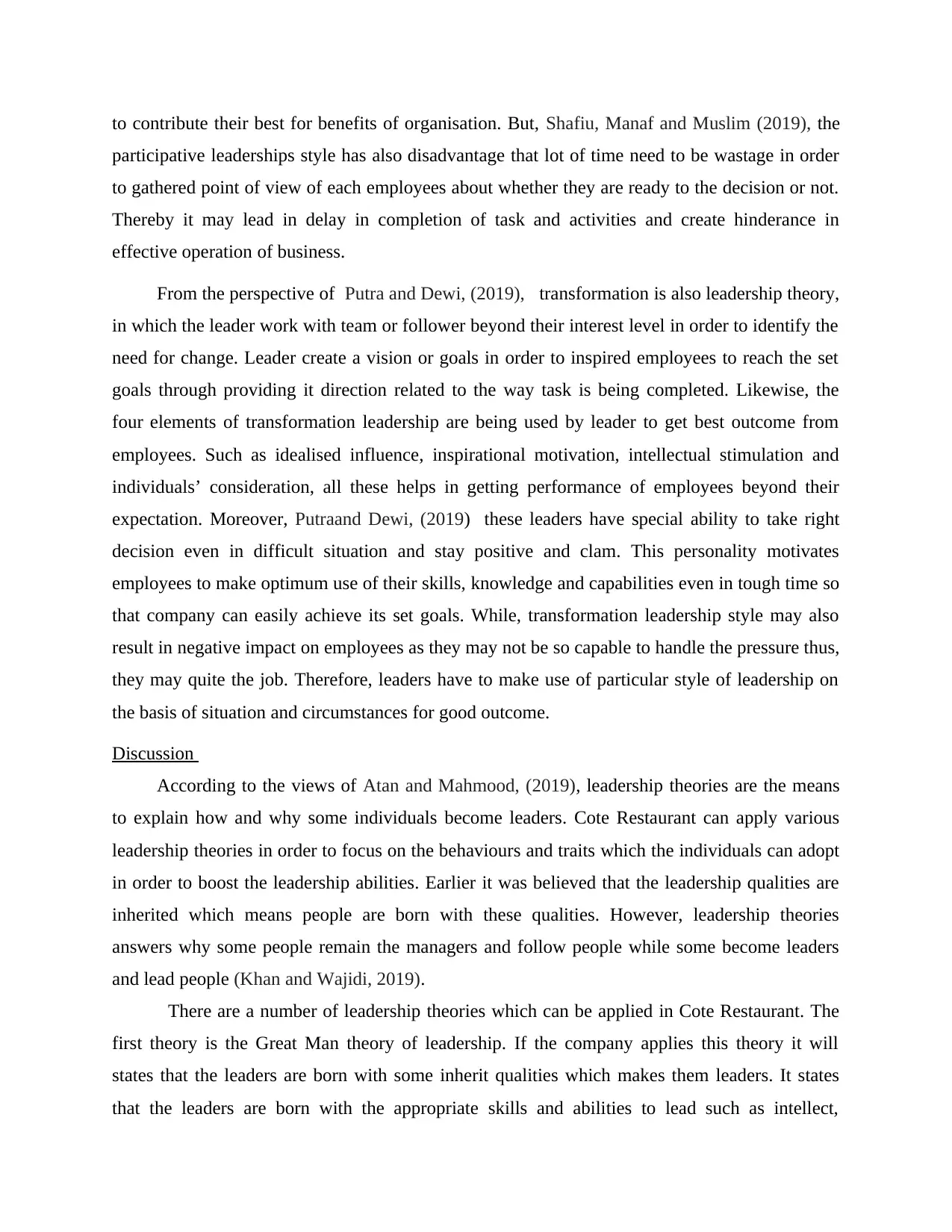
to contribute their best for benefits of organisation. But, Shafiu, Manaf and Muslim (2019), the
participative leaderships style has also disadvantage that lot of time need to be wastage in order
to gathered point of view of each employees about whether they are ready to the decision or not.
Thereby it may lead in delay in completion of task and activities and create hinderance in
effective operation of business.
From the perspective of Putra and Dewi, (2019), transformation is also leadership theory,
in which the leader work with team or follower beyond their interest level in order to identify the
need for change. Leader create a vision or goals in order to inspired employees to reach the set
goals through providing it direction related to the way task is being completed. Likewise, the
four elements of transformation leadership are being used by leader to get best outcome from
employees. Such as idealised influence, inspirational motivation, intellectual stimulation and
individuals’ consideration, all these helps in getting performance of employees beyond their
expectation. Moreover, Putraand Dewi, (2019) these leaders have special ability to take right
decision even in difficult situation and stay positive and clam. This personality motivates
employees to make optimum use of their skills, knowledge and capabilities even in tough time so
that company can easily achieve its set goals. While, transformation leadership style may also
result in negative impact on employees as they may not be so capable to handle the pressure thus,
they may quite the job. Therefore, leaders have to make use of particular style of leadership on
the basis of situation and circumstances for good outcome.
Discussion
According to the views of Atan and Mahmood, (2019), leadership theories are the means
to explain how and why some individuals become leaders. Cote Restaurant can apply various
leadership theories in order to focus on the behaviours and traits which the individuals can adopt
in order to boost the leadership abilities. Earlier it was believed that the leadership qualities are
inherited which means people are born with these qualities. However, leadership theories
answers why some people remain the managers and follow people while some become leaders
and lead people (Khan and Wajidi, 2019).
There are a number of leadership theories which can be applied in Cote Restaurant. The
first theory is the Great Man theory of leadership. If the company applies this theory it will
states that the leaders are born with some inherit qualities which makes them leaders. It states
that the leaders are born with the appropriate skills and abilities to lead such as intellect,
participative leaderships style has also disadvantage that lot of time need to be wastage in order
to gathered point of view of each employees about whether they are ready to the decision or not.
Thereby it may lead in delay in completion of task and activities and create hinderance in
effective operation of business.
From the perspective of Putra and Dewi, (2019), transformation is also leadership theory,
in which the leader work with team or follower beyond their interest level in order to identify the
need for change. Leader create a vision or goals in order to inspired employees to reach the set
goals through providing it direction related to the way task is being completed. Likewise, the
four elements of transformation leadership are being used by leader to get best outcome from
employees. Such as idealised influence, inspirational motivation, intellectual stimulation and
individuals’ consideration, all these helps in getting performance of employees beyond their
expectation. Moreover, Putraand Dewi, (2019) these leaders have special ability to take right
decision even in difficult situation and stay positive and clam. This personality motivates
employees to make optimum use of their skills, knowledge and capabilities even in tough time so
that company can easily achieve its set goals. While, transformation leadership style may also
result in negative impact on employees as they may not be so capable to handle the pressure thus,
they may quite the job. Therefore, leaders have to make use of particular style of leadership on
the basis of situation and circumstances for good outcome.
Discussion
According to the views of Atan and Mahmood, (2019), leadership theories are the means
to explain how and why some individuals become leaders. Cote Restaurant can apply various
leadership theories in order to focus on the behaviours and traits which the individuals can adopt
in order to boost the leadership abilities. Earlier it was believed that the leadership qualities are
inherited which means people are born with these qualities. However, leadership theories
answers why some people remain the managers and follow people while some become leaders
and lead people (Khan and Wajidi, 2019).
There are a number of leadership theories which can be applied in Cote Restaurant. The
first theory is the Great Man theory of leadership. If the company applies this theory it will
states that the leaders are born with some inherit qualities which makes them leaders. It states
that the leaders are born with the appropriate skills and abilities to lead such as intellect,

confidence, communications skills, social skills and charisma (Kadiyono and et.al., 2020). It
suggest that the best leaders are not made instead they are born. The chosen company can apply
this theory by identifying individuals who possess the qualities of a leader. The theory also
suggests that leaders are not just like ordinary people. They have skills and thinking which the
normal people do not possess. It assumes that great leaders can arise when the great need for a
leader arises. The theory also assumes that the leader is an individual who is gifted with the
unique abilities which captures the imagination of masses by nature only. However, Baig and
et.al., (2021) also criticised that, the theory only entails the typical masculine traits to be a leader
as real psychology of a leader do not matches with these traits. Through the application of this
theory the Cote Restaurant can enjoy certain benefits as it does not have to spend money in
training and development for the managers to become leaders as the leaders already possess
those qualities. However, the identification of those leaders might be difficult as some employees
do not have the motivation to be alders and some employees do not want to be accountable for
major tasks.
Bastari, Eliyana and Wijayanti, (2020) provided with another important theory of
leadership. It is the situational theory of leadership. This theory focuses on the implication that a
single leadership style can not applied in all the situations. It suggests that the leadership depends
upon the situations at hand. The leaders adopt their leadership styles as per the situation. It
suggests that the leaders should always correspond to their leadership to respective situation
through assessment of certain variables such as nature of followers ad nature of tasks etc. Cote
Restaurant can apply this theory in the management which ill identify the leaders as per the need
of the activity or task. As per this theory the leaders can exercise a certain form of leadership
which is based on the maturity level of their teams and the leader themselves (Kheir-Faddul and
Dănăiaţă, 2019). The company can apply this theory and select different leaders for different
situations. It can help the company in application of different styles, ideas and behaviours fir
different situations and decision making. The theory can provide various benefits to the chosen
company as it will allow the employees to make better decisions aligned with the situations and
allow them to come up with the best outcomes. However, this can add up additional cost for the
company as every time for a new sitaution a new leader is chosen.
According to Busse and Regenberg (2019), the best kind of leadership theory an
organization can imply is the transformational leadership theory. They should be the one who
suggest that the best leaders are not made instead they are born. The chosen company can apply
this theory by identifying individuals who possess the qualities of a leader. The theory also
suggests that leaders are not just like ordinary people. They have skills and thinking which the
normal people do not possess. It assumes that great leaders can arise when the great need for a
leader arises. The theory also assumes that the leader is an individual who is gifted with the
unique abilities which captures the imagination of masses by nature only. However, Baig and
et.al., (2021) also criticised that, the theory only entails the typical masculine traits to be a leader
as real psychology of a leader do not matches with these traits. Through the application of this
theory the Cote Restaurant can enjoy certain benefits as it does not have to spend money in
training and development for the managers to become leaders as the leaders already possess
those qualities. However, the identification of those leaders might be difficult as some employees
do not have the motivation to be alders and some employees do not want to be accountable for
major tasks.
Bastari, Eliyana and Wijayanti, (2020) provided with another important theory of
leadership. It is the situational theory of leadership. This theory focuses on the implication that a
single leadership style can not applied in all the situations. It suggests that the leadership depends
upon the situations at hand. The leaders adopt their leadership styles as per the situation. It
suggests that the leaders should always correspond to their leadership to respective situation
through assessment of certain variables such as nature of followers ad nature of tasks etc. Cote
Restaurant can apply this theory in the management which ill identify the leaders as per the need
of the activity or task. As per this theory the leaders can exercise a certain form of leadership
which is based on the maturity level of their teams and the leader themselves (Kheir-Faddul and
Dănăiaţă, 2019). The company can apply this theory and select different leaders for different
situations. It can help the company in application of different styles, ideas and behaviours fir
different situations and decision making. The theory can provide various benefits to the chosen
company as it will allow the employees to make better decisions aligned with the situations and
allow them to come up with the best outcomes. However, this can add up additional cost for the
company as every time for a new sitaution a new leader is chosen.
According to Busse and Regenberg (2019), the best kind of leadership theory an
organization can imply is the transformational leadership theory. They should be the one who
⊘ This is a preview!⊘
Do you want full access?
Subscribe today to unlock all pages.

Trusted by 1+ million students worldwide
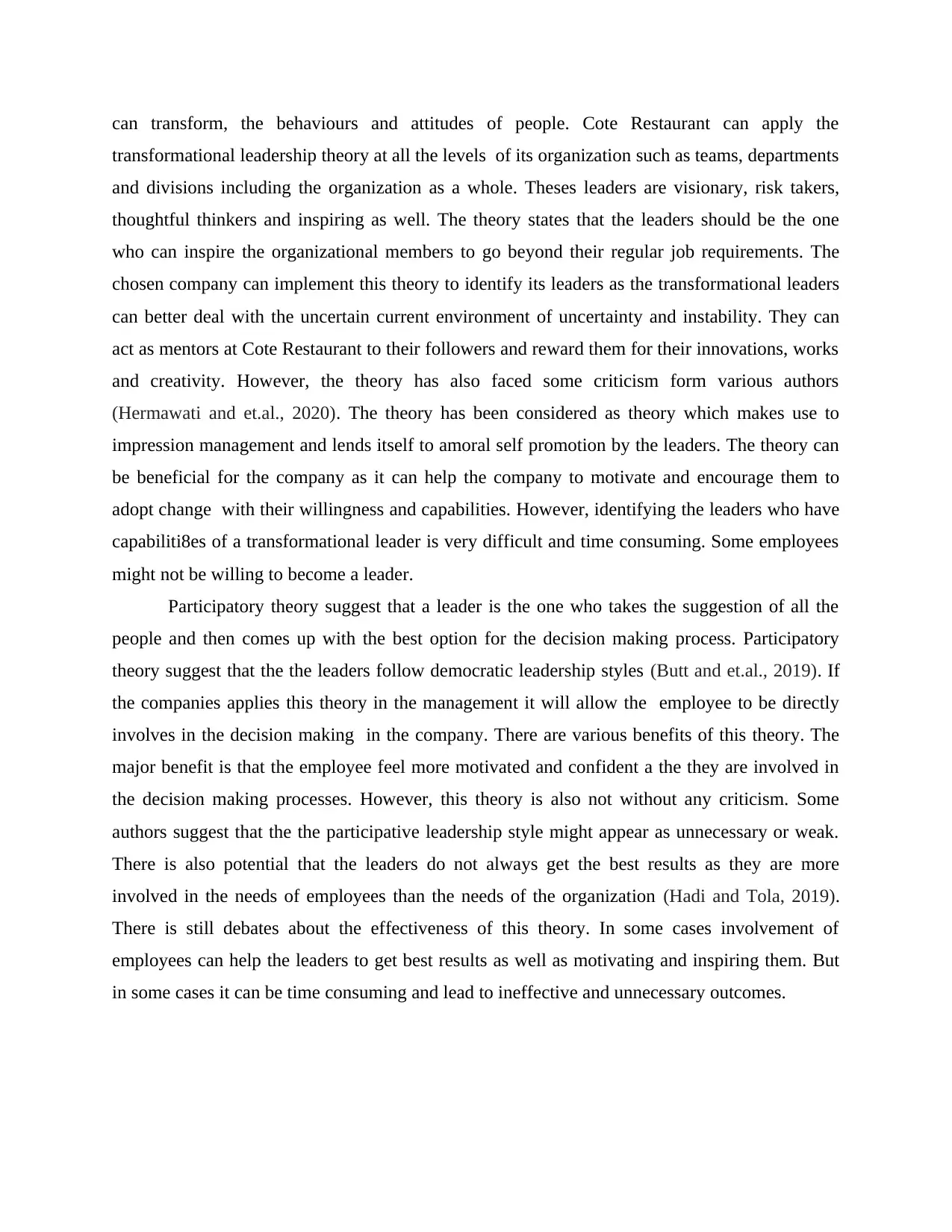
can transform, the behaviours and attitudes of people. Cote Restaurant can apply the
transformational leadership theory at all the levels of its organization such as teams, departments
and divisions including the organization as a whole. Theses leaders are visionary, risk takers,
thoughtful thinkers and inspiring as well. The theory states that the leaders should be the one
who can inspire the organizational members to go beyond their regular job requirements. The
chosen company can implement this theory to identify its leaders as the transformational leaders
can better deal with the uncertain current environment of uncertainty and instability. They can
act as mentors at Cote Restaurant to their followers and reward them for their innovations, works
and creativity. However, the theory has also faced some criticism form various authors
(Hermawati and et.al., 2020). The theory has been considered as theory which makes use to
impression management and lends itself to amoral self promotion by the leaders. The theory can
be beneficial for the company as it can help the company to motivate and encourage them to
adopt change with their willingness and capabilities. However, identifying the leaders who have
capabiliti8es of a transformational leader is very difficult and time consuming. Some employees
might not be willing to become a leader.
Participatory theory suggest that a leader is the one who takes the suggestion of all the
people and then comes up with the best option for the decision making process. Participatory
theory suggest that the the leaders follow democratic leadership styles (Butt and et.al., 2019). If
the companies applies this theory in the management it will allow the employee to be directly
involves in the decision making in the company. There are various benefits of this theory. The
major benefit is that the employee feel more motivated and confident a the they are involved in
the decision making processes. However, this theory is also not without any criticism. Some
authors suggest that the the participative leadership style might appear as unnecessary or weak.
There is also potential that the leaders do not always get the best results as they are more
involved in the needs of employees than the needs of the organization (Hadi and Tola, 2019).
There is still debates about the effectiveness of this theory. In some cases involvement of
employees can help the leaders to get best results as well as motivating and inspiring them. But
in some cases it can be time consuming and lead to ineffective and unnecessary outcomes.
transformational leadership theory at all the levels of its organization such as teams, departments
and divisions including the organization as a whole. Theses leaders are visionary, risk takers,
thoughtful thinkers and inspiring as well. The theory states that the leaders should be the one
who can inspire the organizational members to go beyond their regular job requirements. The
chosen company can implement this theory to identify its leaders as the transformational leaders
can better deal with the uncertain current environment of uncertainty and instability. They can
act as mentors at Cote Restaurant to their followers and reward them for their innovations, works
and creativity. However, the theory has also faced some criticism form various authors
(Hermawati and et.al., 2020). The theory has been considered as theory which makes use to
impression management and lends itself to amoral self promotion by the leaders. The theory can
be beneficial for the company as it can help the company to motivate and encourage them to
adopt change with their willingness and capabilities. However, identifying the leaders who have
capabiliti8es of a transformational leader is very difficult and time consuming. Some employees
might not be willing to become a leader.
Participatory theory suggest that a leader is the one who takes the suggestion of all the
people and then comes up with the best option for the decision making process. Participatory
theory suggest that the the leaders follow democratic leadership styles (Butt and et.al., 2019). If
the companies applies this theory in the management it will allow the employee to be directly
involves in the decision making in the company. There are various benefits of this theory. The
major benefit is that the employee feel more motivated and confident a the they are involved in
the decision making processes. However, this theory is also not without any criticism. Some
authors suggest that the the participative leadership style might appear as unnecessary or weak.
There is also potential that the leaders do not always get the best results as they are more
involved in the needs of employees than the needs of the organization (Hadi and Tola, 2019).
There is still debates about the effectiveness of this theory. In some cases involvement of
employees can help the leaders to get best results as well as motivating and inspiring them. But
in some cases it can be time consuming and lead to ineffective and unnecessary outcomes.
Paraphrase This Document
Need a fresh take? Get an instant paraphrase of this document with our AI Paraphraser

CONCLUSION
From the above report it can be concluded that the leader plays an important role in
managing range of employees within the firm. It understands the individuals wants and
requirement thereby find a particular strategy that could be used to meet their expectancy.
Therefore, at last it can be summarised that leader through its influencing personality is able to
yield maximum productivity through employees and contribute organisation growth.
From the above report it can be concluded that the leader plays an important role in
managing range of employees within the firm. It understands the individuals wants and
requirement thereby find a particular strategy that could be used to meet their expectancy.
Therefore, at last it can be summarised that leader through its influencing personality is able to
yield maximum productivity through employees and contribute organisation growth.
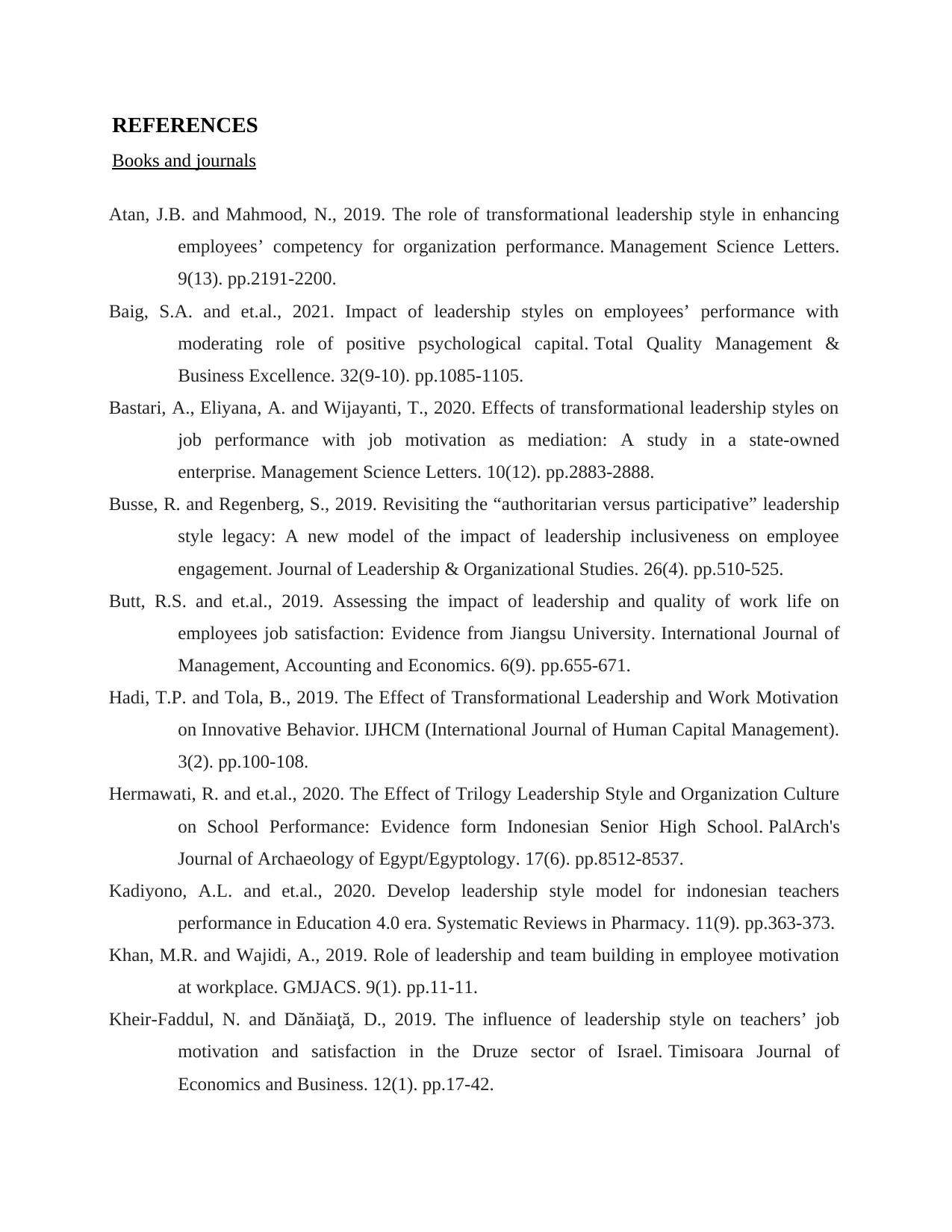
REFERENCES
Books and journals
Atan, J.B. and Mahmood, N., 2019. The role of transformational leadership style in enhancing
employees’ competency for organization performance. Management Science Letters.
9(13). pp.2191-2200.
Baig, S.A. and et.al., 2021. Impact of leadership styles on employees’ performance with
moderating role of positive psychological capital. Total Quality Management &
Business Excellence. 32(9-10). pp.1085-1105.
Bastari, A., Eliyana, A. and Wijayanti, T., 2020. Effects of transformational leadership styles on
job performance with job motivation as mediation: A study in a state-owned
enterprise. Management Science Letters. 10(12). pp.2883-2888.
Busse, R. and Regenberg, S., 2019. Revisiting the “authoritarian versus participative” leadership
style legacy: A new model of the impact of leadership inclusiveness on employee
engagement. Journal of Leadership & Organizational Studies. 26(4). pp.510-525.
Butt, R.S. and et.al., 2019. Assessing the impact of leadership and quality of work life on
employees job satisfaction: Evidence from Jiangsu University. International Journal of
Management, Accounting and Economics. 6(9). pp.655-671.
Hadi, T.P. and Tola, B., 2019. The Effect of Transformational Leadership and Work Motivation
on Innovative Behavior. IJHCM (International Journal of Human Capital Management).
3(2). pp.100-108.
Hermawati, R. and et.al., 2020. The Effect of Trilogy Leadership Style and Organization Culture
on School Performance: Evidence form Indonesian Senior High School. PalArch's
Journal of Archaeology of Egypt/Egyptology. 17(6). pp.8512-8537.
Kadiyono, A.L. and et.al., 2020. Develop leadership style model for indonesian teachers
performance in Education 4.0 era. Systematic Reviews in Pharmacy. 11(9). pp.363-373.
Khan, M.R. and Wajidi, A., 2019. Role of leadership and team building in employee motivation
at workplace. GMJACS. 9(1). pp.11-11.
Kheir-Faddul, N. and Dănăiaţă, D., 2019. The influence of leadership style on teachers’ job
motivation and satisfaction in the Druze sector of Israel. Timisoara Journal of
Economics and Business. 12(1). pp.17-42.
Books and journals
Atan, J.B. and Mahmood, N., 2019. The role of transformational leadership style in enhancing
employees’ competency for organization performance. Management Science Letters.
9(13). pp.2191-2200.
Baig, S.A. and et.al., 2021. Impact of leadership styles on employees’ performance with
moderating role of positive psychological capital. Total Quality Management &
Business Excellence. 32(9-10). pp.1085-1105.
Bastari, A., Eliyana, A. and Wijayanti, T., 2020. Effects of transformational leadership styles on
job performance with job motivation as mediation: A study in a state-owned
enterprise. Management Science Letters. 10(12). pp.2883-2888.
Busse, R. and Regenberg, S., 2019. Revisiting the “authoritarian versus participative” leadership
style legacy: A new model of the impact of leadership inclusiveness on employee
engagement. Journal of Leadership & Organizational Studies. 26(4). pp.510-525.
Butt, R.S. and et.al., 2019. Assessing the impact of leadership and quality of work life on
employees job satisfaction: Evidence from Jiangsu University. International Journal of
Management, Accounting and Economics. 6(9). pp.655-671.
Hadi, T.P. and Tola, B., 2019. The Effect of Transformational Leadership and Work Motivation
on Innovative Behavior. IJHCM (International Journal of Human Capital Management).
3(2). pp.100-108.
Hermawati, R. and et.al., 2020. The Effect of Trilogy Leadership Style and Organization Culture
on School Performance: Evidence form Indonesian Senior High School. PalArch's
Journal of Archaeology of Egypt/Egyptology. 17(6). pp.8512-8537.
Kadiyono, A.L. and et.al., 2020. Develop leadership style model for indonesian teachers
performance in Education 4.0 era. Systematic Reviews in Pharmacy. 11(9). pp.363-373.
Khan, M.R. and Wajidi, A., 2019. Role of leadership and team building in employee motivation
at workplace. GMJACS. 9(1). pp.11-11.
Kheir-Faddul, N. and Dănăiaţă, D., 2019. The influence of leadership style on teachers’ job
motivation and satisfaction in the Druze sector of Israel. Timisoara Journal of
Economics and Business. 12(1). pp.17-42.
⊘ This is a preview!⊘
Do you want full access?
Subscribe today to unlock all pages.

Trusted by 1+ million students worldwide
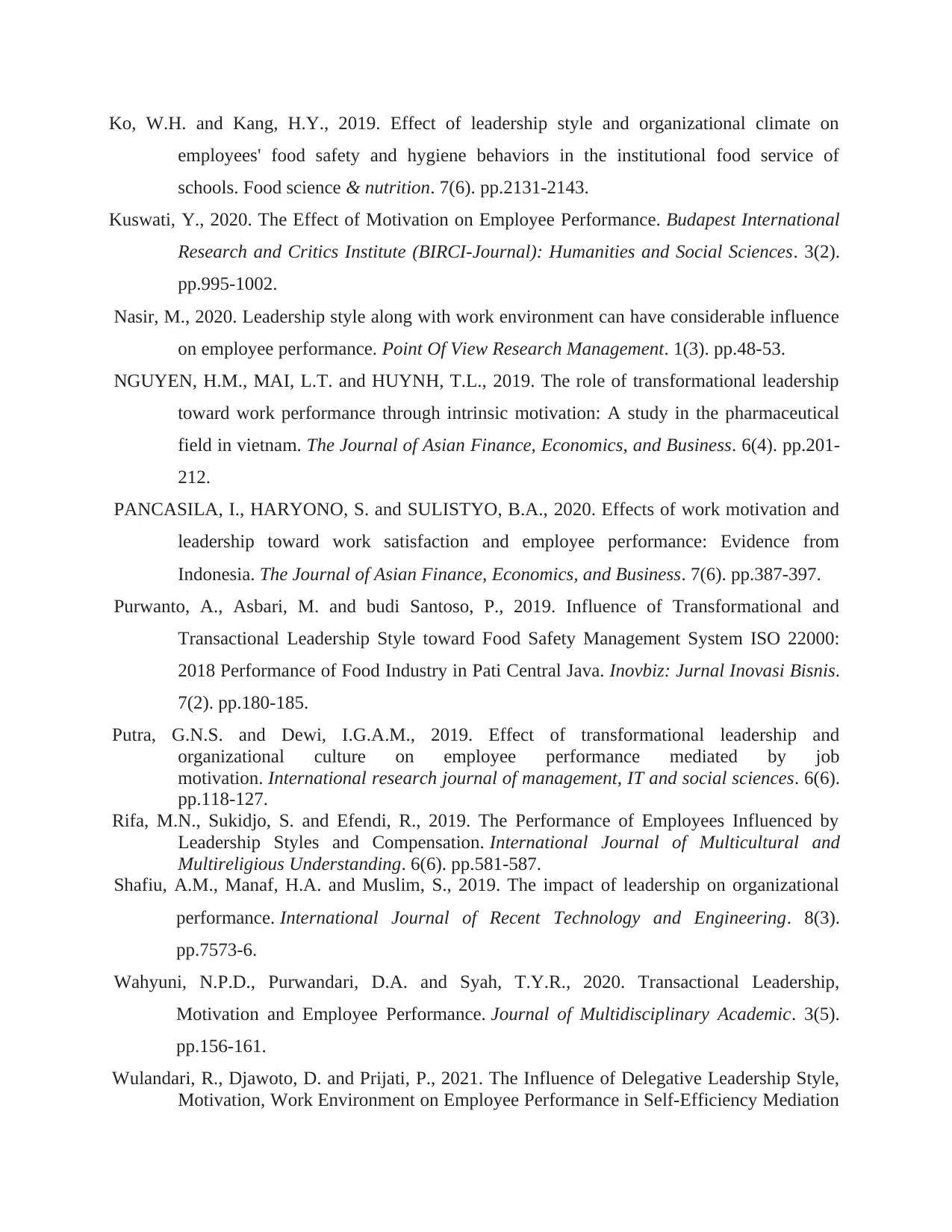
Ko, W.H. and Kang, H.Y., 2019. Effect of leadership style and organizational climate on
employees' food safety and hygiene behaviors in the institutional food service of
schools. Food science & nutrition. 7(6). pp.2131-2143.
Kuswati, Y., 2020. The Effect of Motivation on Employee Performance. Budapest International
Research and Critics Institute (BIRCI-Journal): Humanities and Social Sciences. 3(2).
pp.995-1002.
Nasir, M., 2020. Leadership style along with work environment can have considerable influence
on employee performance. Point Of View Research Management. 1(3). pp.48-53.
NGUYEN, H.M., MAI, L.T. and HUYNH, T.L., 2019. The role of transformational leadership
toward work performance through intrinsic motivation: A study in the pharmaceutical
field in vietnam. The Journal of Asian Finance, Economics, and Business. 6(4). pp.201-
212.
PANCASILA, I., HARYONO, S. and SULISTYO, B.A., 2020. Effects of work motivation and
leadership toward work satisfaction and employee performance: Evidence from
Indonesia. The Journal of Asian Finance, Economics, and Business. 7(6). pp.387-397.
Purwanto, A., Asbari, M. and budi Santoso, P., 2019. Influence of Transformational and
Transactional Leadership Style toward Food Safety Management System ISO 22000:
2018 Performance of Food Industry in Pati Central Java. Inovbiz: Jurnal Inovasi Bisnis.
7(2). pp.180-185.
Putra, G.N.S. and Dewi, I.G.A.M., 2019. Effect of transformational leadership and
organizational culture on employee performance mediated by job
motivation. International research journal of management, IT and social sciences. 6(6).
pp.118-127.
Rifa, M.N., Sukidjo, S. and Efendi, R., 2019. The Performance of Employees Influenced by
Leadership Styles and Compensation. International Journal of Multicultural and
Multireligious Understanding. 6(6). pp.581-587.
Shafiu, A.M., Manaf, H.A. and Muslim, S., 2019. The impact of leadership on organizational
performance. International Journal of Recent Technology and Engineering. 8(3).
pp.7573-6.
Wahyuni, N.P.D., Purwandari, D.A. and Syah, T.Y.R., 2020. Transactional Leadership,
Motivation and Employee Performance. Journal of Multidisciplinary Academic. 3(5).
pp.156-161.
Wulandari, R., Djawoto, D. and Prijati, P., 2021. The Influence of Delegative Leadership Style,
Motivation, Work Environment on Employee Performance in Self-Efficiency Mediation
employees' food safety and hygiene behaviors in the institutional food service of
schools. Food science & nutrition. 7(6). pp.2131-2143.
Kuswati, Y., 2020. The Effect of Motivation on Employee Performance. Budapest International
Research and Critics Institute (BIRCI-Journal): Humanities and Social Sciences. 3(2).
pp.995-1002.
Nasir, M., 2020. Leadership style along with work environment can have considerable influence
on employee performance. Point Of View Research Management. 1(3). pp.48-53.
NGUYEN, H.M., MAI, L.T. and HUYNH, T.L., 2019. The role of transformational leadership
toward work performance through intrinsic motivation: A study in the pharmaceutical
field in vietnam. The Journal of Asian Finance, Economics, and Business. 6(4). pp.201-
212.
PANCASILA, I., HARYONO, S. and SULISTYO, B.A., 2020. Effects of work motivation and
leadership toward work satisfaction and employee performance: Evidence from
Indonesia. The Journal of Asian Finance, Economics, and Business. 7(6). pp.387-397.
Purwanto, A., Asbari, M. and budi Santoso, P., 2019. Influence of Transformational and
Transactional Leadership Style toward Food Safety Management System ISO 22000:
2018 Performance of Food Industry in Pati Central Java. Inovbiz: Jurnal Inovasi Bisnis.
7(2). pp.180-185.
Putra, G.N.S. and Dewi, I.G.A.M., 2019. Effect of transformational leadership and
organizational culture on employee performance mediated by job
motivation. International research journal of management, IT and social sciences. 6(6).
pp.118-127.
Rifa, M.N., Sukidjo, S. and Efendi, R., 2019. The Performance of Employees Influenced by
Leadership Styles and Compensation. International Journal of Multicultural and
Multireligious Understanding. 6(6). pp.581-587.
Shafiu, A.M., Manaf, H.A. and Muslim, S., 2019. The impact of leadership on organizational
performance. International Journal of Recent Technology and Engineering. 8(3).
pp.7573-6.
Wahyuni, N.P.D., Purwandari, D.A. and Syah, T.Y.R., 2020. Transactional Leadership,
Motivation and Employee Performance. Journal of Multidisciplinary Academic. 3(5).
pp.156-161.
Wulandari, R., Djawoto, D. and Prijati, P., 2021. The Influence of Delegative Leadership Style,
Motivation, Work Environment on Employee Performance in Self-Efficiency Mediation
Paraphrase This Document
Need a fresh take? Get an instant paraphrase of this document with our AI Paraphraser
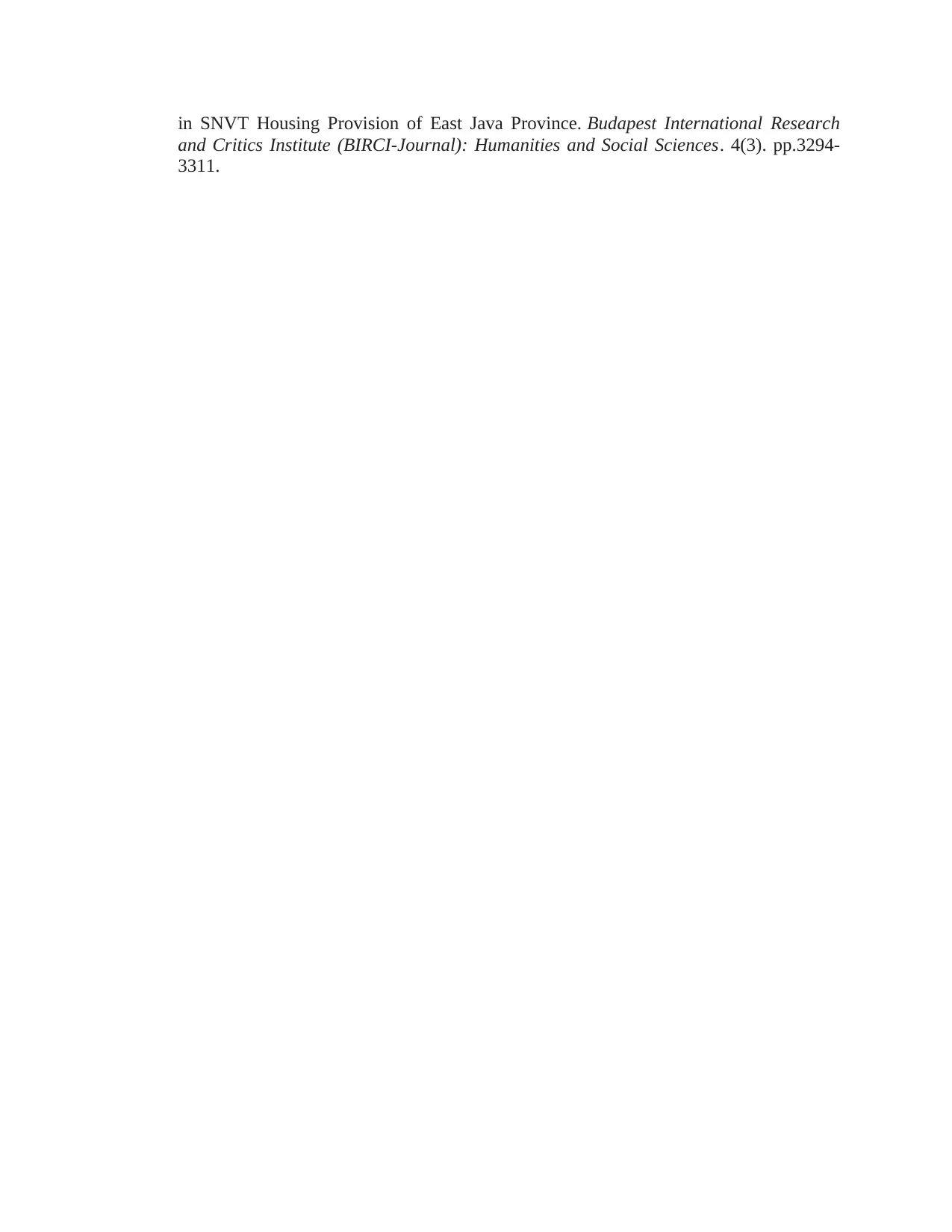
in SNVT Housing Provision of East Java Province. Budapest International Research
and Critics Institute (BIRCI-Journal): Humanities and Social Sciences. 4(3). pp.3294-
3311.
and Critics Institute (BIRCI-Journal): Humanities and Social Sciences. 4(3). pp.3294-
3311.

1
⊘ This is a preview!⊘
Do you want full access?
Subscribe today to unlock all pages.

Trusted by 1+ million students worldwide
1 out of 12
Related Documents
Your All-in-One AI-Powered Toolkit for Academic Success.
+13062052269
info@desklib.com
Available 24*7 on WhatsApp / Email
![[object Object]](/_next/static/media/star-bottom.7253800d.svg)
Unlock your academic potential
Copyright © 2020–2025 A2Z Services. All Rights Reserved. Developed and managed by ZUCOL.





